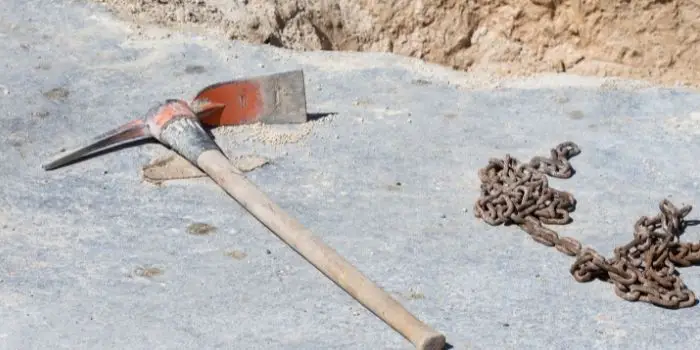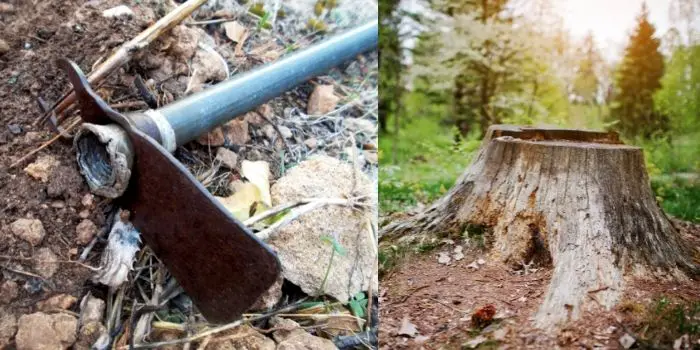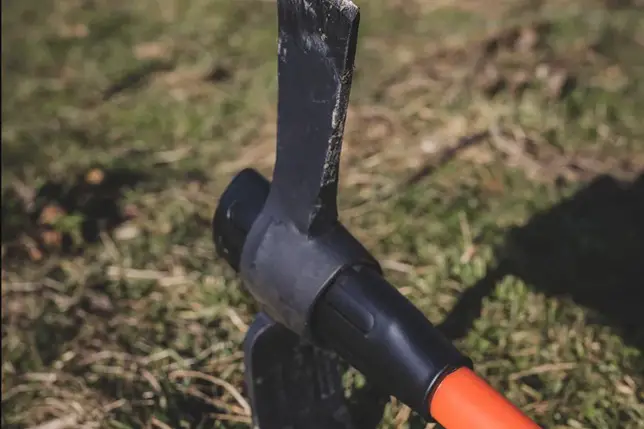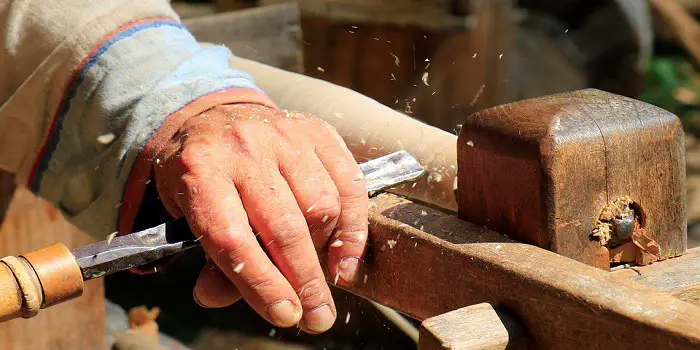
A mattock is often called a Polaski in the United States because Edward Polaski, a forest ranger at the turn of the 20th century, created the tool.
While the name mattock may not ring any bells, you have probably seen this tool either in use or in shows or movies where the characters are digging for gold or other valuable items.
Today, the mattock is used primarily for digging and chopping around the world. It is a specialized tool that is mostly used outdoors.
What is a Mattock?
A mattock is a tool that looks quite similar to a pickaxe. It features a long handle made of either wood or fiberglass.
The head of the mattock may consist of an adze or horizontal blade on one side and a standard axe blade on the other.
Variations of the mattock, which include the cutter mattock, may have a pick or narrow, pointed blade on one side with an adze on the other.
Although superficially similar to a pickaxe, the mattock is quite different.
The pickaxe normally consists of a long, narrow blade on one end with a short chisel-like blade on the other.
The mattock is really two types of axes, one horizontal and a shorter, vertical blade on each side.
What is a Mattock Used for?
The most common use for a mattock is associated with gardening and landscaping because it’s a tool designed to break up and remove dirt from the ground.
The shorter, vertical blade is used to chop through the tree roots in the ground to break them up so they can be removed.
The longer adze or horizontal blade is used to move soil, dig trenches, and remove dirt from the ground.
If you are using a pick mattock, then the pick portion is used to break up harder or densely packed soil, including rocks and stones.
The sharp pick portion of this variation can bust up earth and rocks far easier compared to a standard mattock.
If you are using a claw mattock, the claw portion can dig out weeds and cultivate the ground.
The claw is a handy tool for removing earth to help plant a garden or remove weeds inside a garden.
How to Use a Mattock Tool Correctly?
Using a mattock requires using a special technique that maximizes the impact while protecting the knees and back of the person using it.
Grip the middle of the handle with your dominant hand. Then, place your other hand at the base.
While keeping your back straight, feet apart, and knees flexed, bend at the waist when pulling the mattock back.
Let the weight of the mattock be the main force that brings it to the ground.
You’ll want to swing the mattock in an arc that starts at shoulder level and proceeds downward to the ground.
If you use short chops, that will save energy so you can continue using the mattock without tiring.
The key is to protect your lower back so you do not strain the muscles.
Repeat the movement until you have sufficiently broken up the ground or achieved a specific objective.
For cutting through tree roots, flip the head around and use the vertical blade or adze and continue with the same striking motion.
If you need to break up rocks or dislodge harder objects, a pick mattock is generally best.

How to Remove Tree Stumps Using a Mattock?
There is no question that the mattock is the least expensive and safest way to remove a tree stump.
However, it can also be the most exhausting method, especially with larger stumps.
You can use a standard or pick mattock to remove a tree stump.
You can move to the next step if the stump is fresh and soft.
However, if the stump is old and has hardened, you will need to break it up with the adze side of the mattock. This will remove much of the material from the stump.
Next, you will need to break up the roots that extend from the stump.
Strike the ground around the stump using the axe or a pick side of the mattock. This will break through the hardened soil along with the roots.
You should keep going until you completely circle the stump.
Use the horizontal blade to scoop out the loose soil to expose the roots, then flip the mattock around to the axe side and chop.
Your goal is to remove enough soil to expose all the tree roots, then cut the roots away from the stump.
You should have the ball of the root left after you are done. Once completed, you may need a digging bar to lift the root from the ground.
If the root ball is large, you need to circle it with a chain and attack a tractor to pull it out.

Pick Mattock vs. Cutter Mattock: What’s the Difference?
Although somewhat similar in appearance, there are differences between the pick and cutter versions of the mattock.
A pick mattock has a pick on one side, a long, tapered end that is designed to bust up hardened soil or breakthrough rocks.
It looks quite similar to a pickaxe.
However, a pick mattock will generally have a vertical axe blade on the other side, while a pickaxe will have a short, chisel-like point on the other side.
A cutter mattock will have a long, vertical blade on one side.
This is best used for cutting up roots and stumps. The blade itself is slightly curved to match the downward swing by the user.
This allows the end to penetrate the roots and dig into larger amounts of soil that can be removed.
Both versions are quite useful, but the cutter mattock is generally better for removing tree stumps.
Although the pick mattock can be handy if there is hardened soil or plenty of large rocks or stones surrounding the root of the tree.
Mattock vs. Pulaski vs. Pickaxe: What to Choose for Digging and Gardening?
Mattock is a sturdy grubbing tool, which is why it is also known as a grubbing ax, or a grubbing hoe.
When using the mattock tool, the thing to remember is that it’s not an ideal tool for chopping down trees or splitting firewood.
They are instead good at digging and slicing through tough roots. You should basically use them for heavy work on tougher grounds.
Unlike the Mattock tool, Pulaski is a double-ended firefighting tool used for fighting wildfires.
You can consider it to be a firefighting axe with an adze.
The Pulaski axe is a better tool when you need to chop wood, dig holes in the soil, or for building fire breaks.
It’s a type of normal gardening that can be used for general excavation.
The pickaxe, on the other hand, is good for busting stumps and breaking hard soil. You can also use it for splitting wood and for prying out brushes.
The pickaxe is, however, not the perfect tool for chopping.
When looking for a better-suited tool for gardening, landscaping, or chopping exposed tree roots, it’s good to consider the specific job for which you need a tool.
Final thoughts
A mattock is quite a handy tool for everyday gardening, landscaping, and removing smaller tree stumps.
You can also use it on larger tree stumps if you have a chain, tractor, or large vehicle handy to pull out the stump.
If, however, you need to choose a tool for fighting wildfires or chopping wood, Pulaski is your option.

Hi, I am Mark Garner a professional carpenter, woodworker, and DIY painter. I live in the small city of Peoria, Arizona as a semi-retired woodworker. I have started this blog with a simple motive to help you with my wood experience in this sector. If you like to know more about what I love doing and how it all got started, you can check more about me here.




